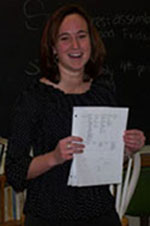
 |
In "Thinking about Multimodality," Pamela Takayoshi, Gail Hawisher, and Cindy Selfe (2007, p. 3) write: "Whatever profession students hope to enter in the 21 st Century--game design, archeology, science and engineering, the military, the entertainment industry, and medicine--they can expect to read and be asked to help compose multimodal texts of various kinds . . ." While not noted specifically in Takayoshi, Hawisher, and Selfe's list, teachers, too, are among those professionals who must be adequately prepared through their educational experiences to both "consume" and "compose" multimodal texts. This need is obvious among pre-service English teachers if they are to eventually employ multimodal pedagogical strategies into their own composition assignments. Some exposure to such strategies may be currently taking place, as suggested by the students who were interviewed and videotaped for this article. And while their responses are limited to their experiences at The University of Findlay and its neighboring high schools in Northwest Ohio, their words indicate that increased modeling of multimodal pedagogies at the university level is warranted.
When prompted, the student interviewees, Jeremy and Kelsey, could recall points where multimodality had entered their secondary English instruction either while they were in high school themselves or upon their observation and student-teaching in high schools as part of their preparation as English educators. Jeremy, in particular, noted the importance of music as a tool for engaging and challenging student writers to think and compose analytically. However, in this instance, and in several others recounted by Jeremy and Kelsey, the multimodality employed worked as a "hook" rather than as the mode of expression itself. In other words, the instructional strategy utilized the visual or aural as a means to entice students to make meaning rather than as a tool of meaning making in and of itself. Put yet another way, the multimodal had no rhetorical power beyond its effect in luring the student to what might arguably be described as a "traditional assignment." However, if that same assignment were altered to challenge students to author their own multimodal texts, then students would have the opportunity to "demonstrate a strong awareness and understanding of how music and images are used as appeals in arguments and, further, how effective these modalities can be in creating and establishing meaning" (Takayoshi, Hawisher, & Selfe, 2007, p. 5).
The point, then, is to "refresh" perspectives on what it means to compose a "written work" or what constitutes a "written work." Takayoshi, Hawisher, and Selfe (2007, p. 3) write that "composition instruction is poised on the precipice of the change" from a purely text-driven to a more multimodal conceptualization of writing; and with that said, it seems likely that pre-service English teachers may play a vital role in instituting such a change. However, the empowerment of these pre-service teachers hinges on the actualization of these "[re]fresh[ing]" multimodal "perspectives" among those in charge of the novice teachers' education and preparation.